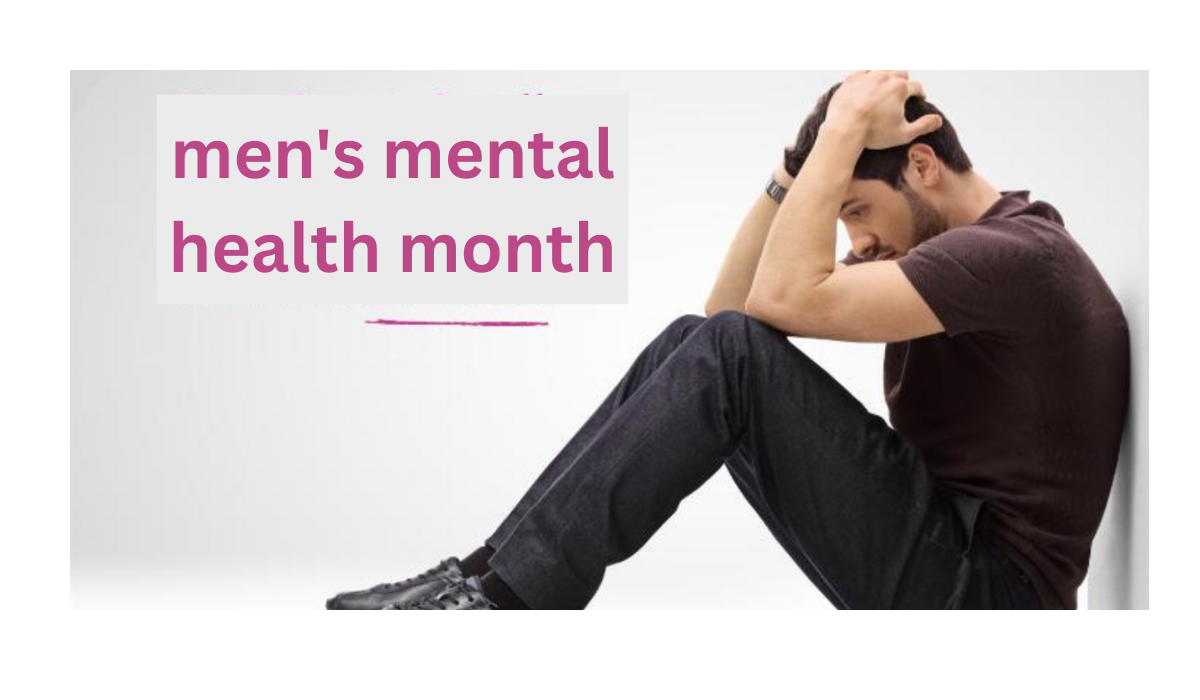When we think of strength, we often picture someone who is physically tough, unshaken, resilient in the face of challenges. But what about emotional strength? What about the kind of resilience it takes to admit you’re struggling, to seek help, or even just to talk about what’s going on inside?
Every year, Men’s Mental Health Month, observed in June, serves as a vital reminder of the silent battles many men face. This month is dedicated to raising awareness, dismantling stigma, and encouraging men to prioritize their mental health with the same urgency they give to their physical health.
In this article, we’ll explore the history and purpose of Men’s Mental Health Month, the unique challenges men face, key statistics, real-world stories, tips for support, and how we can all play a role in promoting emotional well-being for men around the world.
1. The Origins and Purpose of Men’s Mental Health Month
Men’s Mental Health Month is part of a larger movement to address gender-based disparities in mental health awareness and treatment. While mental health months like May’s Mental Health Awareness Month provide broad support for mental well-being, June puts a spotlight specifically on men—because they need it.
Why a dedicated month for men’s mental health?
Men are less likely to seek help for mental health issues, more likely to die by suicide, and often socialized to suppress emotions. This month aims to:
-
Break cultural and societal stigma around men showing vulnerability.
-
Promote access to mental health resources and education.
-
Encourage early intervention and open conversation.
-
Empower men to take control of their emotional well-being.
By creating a safe and visible platform for these discussions, we begin to shift the narrative from silent suffering to shared strength.
2. The Unique Challenges Men Face with Mental Health
Societal Expectations and Masculinity
From a young age, boys are often taught to “man up,” “be tough,” or “don’t cry.” These harmful messages reinforce the idea that expressing emotions is a sign of weakness. This expectation creates emotional bottlenecks, making it difficult for men to process or express feelings in healthy ways.
As adults, these pressures can become overwhelming. Men may:
-
Suppress emotions to maintain a “strong” appearance.
-
Use substances like alcohol to self-medicate.
-
Channel emotional distress into anger or aggression.
-
Avoid professional help due to embarrassment or pride.
Work and Financial Pressures
Men often feel responsible for financial stability and family security. While this pressure isn’t exclusive to men, traditional gender roles still associate “providing” with masculinity. Stress from job insecurity, unemployment, or overworking can significantly impact mental health.
Isolation and Lack of Support Systems
Many men lack the emotional support networks that women often cultivate. They might have friends, but not friends they can cry or be vulnerable with. Without trusted connections, men may isolate themselves, increasing the risk of anxiety, depression, and suicidal thoughts.
3. Eye-Opening Statistics You Should Know
Understanding the numbers behind Men’s Mental Health Month makes the urgency of this conversation clear:
-
Men die by suicide 3.9 times more often than women in the U.S., according to the American Foundation for Suicide Prevention.
-
Only 36% of mental health therapy clients are male.
-
Depression in men often goes undiagnosed due to different symptom presentation—anger, irritability, and risk-taking instead of sadness or crying.
-
Men are less likely to seek help or talk to others about emotional problems.
-
Black, Indigenous, and men of color (BIPOC) face compounded challenges due to racial trauma, access disparities, and cultural stigma.
These numbers aren’t just statistics—they represent fathers, sons, brothers, and friends who are often struggling in silence.
4. How to Recognize the Signs in Men
Unlike the common image of depression or anxiety, men often experience and express emotional distress differently. Recognizing these signs is essential for early support:
-
Increased irritability or anger
-
Withdrawal from social circles
-
Changes in sleep or eating habits
-
Substance misuse
-
Risky behaviors (e.g., reckless driving, gambling)
-
Decreased motivation or productivity
-
Frequent physical complaints (like headaches or fatigue)
It’s important to approach men with empathy and openness when addressing these symptoms. Avoid judgment and instead ask open-ended, caring questions.
5. Real Stories: Courage in Vulnerability
One of the most powerful aspects of Men’s Mental Health Month is hearing real stories from real men. Here are a few narratives (names changed for privacy) that reflect the silent strength and courage of opening up:
Tom’s Story – From Anger to Awareness
Tom, a 35-year-old firefighter, struggled for years with anger and emotional outbursts. After a colleague’s suicide, he attended a workplace mental health seminar. He saw himself in the stories being told and decided to seek therapy. “It changed my life,” he said. “I realized I wasn’t weak. I was human.”
Carlos’s Journey – Breaking Generational Patterns
Carlos grew up in a family where men didn’t talk about feelings. After years of pushing through depression alone, he found a men’s support group in his city. “The first time I said, ‘I’m not okay,’ out loud—it felt like I could breathe again,” he shared.
6. Destigmatizing Mental Health for Men
The stigma surrounding men’s mental health is deeply rooted in cultural norms, media portrayal, and outdated definitions of masculinity. Here’s how we can start changing that:
Reframe Masculinity
We need to redefine what it means to be a “real man.” Courage, honesty, empathy, and vulnerability are not weaknesses—they’re strengths. Showing emotion should not be seen as “unmanly,” but as a sign of self-awareness and maturity.
Normalize Therapy and Support
The more public figures, celebrities, athletes, and influencers speak openly about therapy and mental health, the more acceptable it becomes. Visibility matters.
Education from a Young Age
Mental health should be discussed with boys in schools and at home. Teaching emotional literacy, empathy, and self-awareness early can change future generations.
7. How You Can Support Men’s Mental Health
Whether you’re a friend, partner, coworker, or family member, your support can be life-changing. Here’s how you can help:
1. Start the Conversation
Sometimes, the hardest part is saying “Are you okay?” and truly listening. Let them speak without trying to fix it immediately.
2. Be Nonjudgmental
Avoid minimizing their feelings or offering toxic positivity. Instead of “Cheer up,” say “That sounds really hard. I’m here for you.”
3. Encourage Professional Help
Gently suggest therapy, coaching, or support groups without making it seem like something is wrong with them. Share resources that may help.
4. Promote Healthy Outlets
Support hobbies and activities that boost emotional health—sports, art, journaling, volunteering, or simply talking walks.
5. Create Safe Spaces
Make it known that your relationships are judgment-free zones. Let the men in your life know that vulnerability is welcome.
8. Resources Available During Men’s Mental Health Month
Many organizations focus on men’s mental health, especially during June. Here are a few:
-
Movember Foundation – Originally focused on men’s physical health, now a major advocate for mental health.
-
HeadsUpGuys.org – A resource hub specifically for men battling depression.
-
Man Therapy – A humorous but impactful website that offers therapy resources for men.
-
The Good Men Project – A digital community that challenges traditional masculinity norms.
-
National Suicide Prevention Lifeline – 988 (U.S.) – A confidential line available 24/7.
Local community centers, mental health professionals, and workplaces may also offer events, workshops, or screenings during this month.
9. Workplace Mental Health: A Critical Conversation
Many men spend a large portion of their lives at work. The workplace can either be a stressor or a support system. Employers can take part in Men’s Mental Health Month by:
-
Hosting mental health workshops or seminars.
-
Providing access to Employee Assistance Programs (EAPs).
-
Encouraging time off for mental health.
-
Promoting an open, stigma-free culture.
Employees can also take initiative by forming men’s discussion groups, sharing personal experiences, and checking in with peers.
10. Looking Ahead: A Culture of Compassion and Strength
Men’s Mental Health Month isn’t just a month-long campaign. It’s a starting point for year-round awareness, support, and change. Every conversation, resource, and small act of kindness counts.
When we create a culture where men feel safe, supported, and empowered to prioritize their emotional well-being, everyone benefits—families are stronger, workplaces are healthier, and communities are more connected.
Let’s continue to break the silence. Let’s redefine strength. Let’s talk about men’s mental health—not just in June, but every day.
Conclusion
Men’s Mental Health Month reminds us that mental health isn’t a gendered issue—it’s a human one. But men have unique hurdles that need focused attention, compassion, and tailored solutions. By raising awareness, reducing stigma, and creating supportive environments, we can help millions of men find the courage to seek help and heal.





